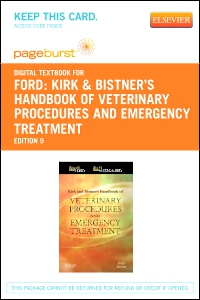
Kirk & Bistner's Handbook of Veterinary Procedures and Emergency Treatment - Elsevier eBook on VitalSource (Retail Access Card), 9th Edition
Elsevier eBook on VitalSource - Access Card

Kirk and Bistner's Handbook covers not only the management of emergency conditions, but also strategies for dealing with hundreds of routine diagnostic and treatment challenges in small animals. A user-friendly format provides instant access to vital information -- making it an ideal resource in emergency situations -- and its convenient organization by both body systems and presenting signs makes it easy to reach a diagnosis and determine a treatment plan for all clinical situations.
-
- NEW! Quick Reference boxes include potential causes of each clinical abnormality and associated signs, step-by-step diagnostic plans, and clinical algorithms.
- NEW! The latest vaccination guidelines include protocols for dogs and cats at low, medium, and high risk of exposure to infectious diseases.
- UPDATED coverage keeps students current with the latest on pain assessment, prevention, and treatment.
- Step-by-step instructions and illustrations are provided for all major emergency and non-emergency clinical procedures.
- A logical, easy-to-use format lists all emergency conditions in alphabetical order, and includes quick reference boxes calling out key information such as clinical tips and cautions.
- Clear, concise guidelines help in evaluating clinical signs and laboratory test data.
- Clinical algorithms make it easier to identify and treat abnormalities.
- Guidelines for assessment and treatment include practical advice and solutions, how to examine the small animal patient using a body systems and problem list approach, and a review of basic diagnostic procedures used in daily practice.
- Coverage of toxicological emergencies describes how to manage exposures and poisonings.
- A quick reference guide to the management of the emergency patient is conveniently located on the inside cover.
- A comprehensive drug formulary makes lookup easy, and includes proprietary names, actions/use of each drug, formulations, recommended dosages, and special precautions, with emergency medications highlighted for fast reference
- This all-in-one reference includes practical coverage of emergency procedures, physical assessment in sickness and health, routine and advanced testing procedures, diagnostic tests sampling, preparation, procedures, and interpretation.
-
- Quick Reference boxes include potential causes of each clinical abnormality and associated signs, step-by-step diagnostic plans, and clinical algorithms.
- The latest vaccination guidelines include protocols for dogs and cats at low, medium, and high risk of exposure to infectious diseases.
- Updated coverage keeps you current with the latest on pain assessment, prevention, and treatment.
-
Section 1: Emergency Care
Prehospital management of the injured animal
Initial emergency examination, management, and triage
Emergency diagnostic and therapeutic procedures
Pain: assessment, prevention, and management
Emergency management of specific conditions
Section 2: Patient Evaluation and Organ System Examination
Patient evaluation
The medical record
The organ system examination
Section 3: Clinical Signs
Abdominal enlargement with ascites
Abdominal enlargement without ascites
Aggression
Alopecia (See hair loss)
Ataxia (See incoordination)
Blindness (See vision loss)
Blood in urine: hematuria, hemoglobinuria, myoglobinuria
Coma: loss of consciousness
Constipation (obstipation)
Cough
Coughing blood: hemoptysis
Deafness or hearing loss
Decreased urine production: oliguria and anuria
Diarrhea, acute-onset
Diarrhea, chronic
Difficulty breathing or respiratory distress: cyanosis
Difficulty breathing or respiratory distress: dyspnea
Difficulty swallowing: dysphagia
Hair loss: alopecia
Hemorrhage (See spontaneous bleeding)
Icterus (See yellow skin)
Incoordination: ataxia
Increased urination and water consumption: polyuria and polydipsia
Itching or scratching: pruritus
Jaundice (See yellow skin)
Joint swelling: arthropathy
Loss of appetite: anorexia
Lymph node enlargement: lymphadenomegaly
Pain
Painful urination: dysuria (See straining to urinate)
Painful defecation: dyschezia (See straining to defecate)
Rectal and anal pain (See straining to defecate)
Regurgitation
Seizures (convulsions or epilepsy)
Sneezing and nasal discharge
Spontaneous bleeding: hemorrhage
Straining to defecate: dyschezia
Straining to urinate: dysuria
Swelling of the limbs: peripheral edema
Uncontrolled urination: urinary incontinence
Vision loss: total blindness
Vomiting
Vomiting blood: hematemesis
Weakness, lethargy, fatigue
Weight loss: emaciation, cachexia
Yellow skin or mucous membranes: icterus (or jaundice)
Section 4: Diagnostic and Therapeutic Procedures
Routine Procedures
Dermatologic Procedures
Advanced Procedures
Section 5: Laboratory Diagnosis and Test Protocols
Common reference range values
Sample handling
Submission requirements for rabies suspects
Histopathology and cytopathology
Biochemistry--routine
Routine biochemical testing
Special diagnostic tests and test protocols
Hemostasis and coagulation
Endocrinology
Immunology
Infectious disease serology and microbiology
Urine
Section 6: Charts and Tables
6-1: Emergency Hotlines
6-2: Dog Breeds Recognized by the American Kennel Club (AKC)
6-3: Cat Breeds Recognized by the Cat Fanciers' Association (CFA)
6-4: Useful Information for Rodents and Rabbits
6-5: Determination of the Sex of Mature and Immature Rodents and Rabbits
6-6: Blood Values and Serum Chemical Constituents for Rodents and Rabbits
6-7: Ferrets--Physiologic, Anatomic, and Reproductive Data
6-8: Hematologic Values for Normal Ferrets
6-9: Serum Chemistry Values for Normal Ferrets
6-10: Electrocardiographic Data for Normal Ferrets
6-11: Conversion of Body Weight in Kilograms to Body Surface Area in Meters Squared for Dogs
6-12: Conversion of Body Weight in Kilograms to Body Surface Area in Meters Squared for Cats
6-13: French Scale Conversion Table
6-14: International System of Units (SI) Conversion Guide
6-15: Units of Length, Volume, and Mass in the Metric System
6-16: Vaccines Licensed for Use in Dogs in the United States
6-17: Vaccines Licensed for Use in Cats in the United States
6-18: Canine Vaccination Recommendations-Initial Puppy Series
6-19: Canine Vaccination Recommendations-Adult
6-20: Feline Vaccination Recommendations-Initial Kitten Series
6-21: Feline Vaccination Recommendations-Adult
6-22: Compendium of Animal Rabies Prevention and Control, 2005, National Association of State Public Health Veterinarians, Inc. (NASPHV)
6-23: Prescription Writing Reference... Do's and Don'ts
6-24: Common Drug Indications and Dosages

 as described in our
as described in our 